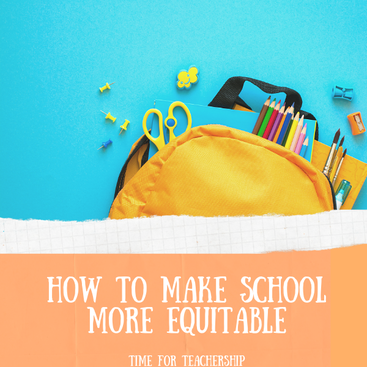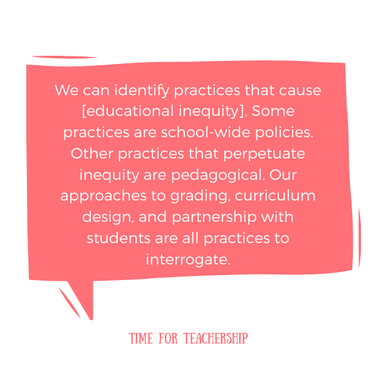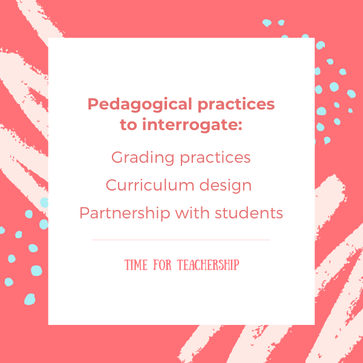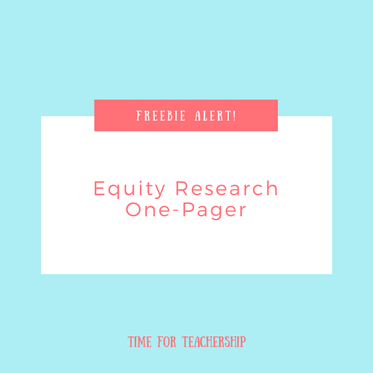|
Many educators have been sharing resources and suggestions for talking to students about racism and police brutality in the last few weeks. We absolutely need to continue having these conversations with our students. We also should be asking what we can do to address the problem of systemic racism. I’m trying to use my area of expertise to focus on anti-racism work in educational contexts—taking steps to identify and eliminate places where our schools or classrooms are perpetuating systemic racism. Often, these practices are unintentional and involve a lot of self work. We may need to read up on the practices that perpetuate the opportunity gap, and un-learn these practices while we learn better ones. In this post, I’ll share some of the major pedagogical shifts for you to consider as you think about how your school can advance educational equity moving forward. As you read, consider the hat(s) you wear in your school—teacher, department chair, instructional coach, administrator—and think about what you can do in your role to support larger shifts towards equity, in your own classroom and across the school. What does the research say? First, educational inequity exists. Black and Brown students, students new to English, low-income students, students with IEPs (National Center for Educational Statistics), and transgender students (Gender Spectrum) are being severely underserved by traditional educational systems. Second, we can identify practices that cause this marginalization. Some practices are school-wide policies. Discipline policies that keep students out of classes for non-violent acts, like not following codes or acting “unfeminine,” are disproportionately pushing Black girls out of schools. Preventing students from using the bathroom that aligns with their gender identity or failing to provide gender neutral bathrooms leads to trans students avoiding bathrooms or avoiding school itself. Other practices that perpetuate inequity are pedagogical. Our approaches to grading, curriculum design, and partnership with students are all practices to interrogate. Let’s take a look at each. Grading practices. Grading student work holistically instead of analytically (i.e., a grade for each standard being assessed) leads to unintentional educator bias, which often perpetuates the so-called “achievement” gap. Grading each of the year’s assessments with equal weight (instead of weighting end-of-year grades more than start-of-year grades and replacing draft submission grades with revised work grades) perpetuates the opportunity gap because this approach to grading does not value academic growth over time. Instead, it rewards students who entered the class on (or close to) grade level and punishes students who were already behind. Teachers who measured skill growth over time on mastery-based scoring scales noted a 34% gain in student achievement compared to traditional grading systems. Curriculum design. Traditional “sit and get” instruction followed by graded quizzes may continue to disengage students who have, historically, not had success in school. However, research on project-based learning as an instructional strategy has seen positive results for historically low-performing students. PBL classrooms have higher student engagement, student motivation to learn, student independence and attendance compared to traditional classrooms. Students using PBL understand the content on a deeper level, retain content longer, and perform as well or better on high-stakes tests than students in traditional settings. Partnership with students. If we communicate the message that a valued student is one who is quiet and compliant, we deny students the opportunity to be fully engaged, self-directed learners who take ownership of their academic growth. But, when students are given opportunities to co-construct their learning environment and learning activities, research has found students have better relationships with their teachers and peers, improved feelings of competence and positive self-regard, and are overall, more engaged, which ultimately, leads to improved academic performance. What do I do now? Consider the policies you can influence given your role in your school. For teachers, that will likely be the pedagogical policies. Take stock of your own policies. What could be adjusted to be more equitable? Once you’ve identified your area for growth, determine what you might want to learn more about this summer to prepare to implement your updated policy in the fall. Ask your school or district leaders about related PD opportunities. Check out educational podcasts, books, and blogs that discuss these topics. Next month, I’ll be holding free 1-hour online masterclasses that address the pedagogical shifts discussed in this post. If you are a school leader, consider providing summer PD opportunities or resource recommendations for teachers to do some asynchronous self-paced learning on these topics. If you still have time left in the school year, consider discussing these shifts before summer break. You may want to let the ideas of these big shifts come up organically. For example, ask teachers to identify what has been challenging this year and also identify moments of success. Then, have teachers notice themes of success and how they may connect to themes of challenges raised. As you facilitate, you could highlight emerging themes that connect to the research. That could look like:
Note: If you are in a leadership role, leading a staff PD or PLC meeting, this activity can be part of the meeting, but you could also informally suggest this activity to colleagues by sharing that you tried it and found it helpful to prepare for fall. If your colleagues or supervisors need a quick summary of the research and the instructional pivots to close the opportunity gap, I made a one-pager for you.
0 Comments
Leave a Reply. |
Details
For transcripts of episodes (and the option to search for terms in transcripts), click here!
Time for Teachership is now a proud member of the...AuthorLindsay Lyons (she/her) is an educational justice coach who works with teachers and school leaders to inspire educational innovation for racial and gender justice, design curricula grounded in student voice, and build capacity for shared leadership. Lindsay taught in NYC public schools, holds a PhD in Leadership and Change, and is the founder of the educational blog and podcast, Time for Teachership. Archives
May 2024
Categories |





 RSS Feed
RSS Feed